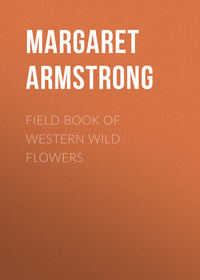Kitap dosya olarak indirilemez ancak uygulamamız üzerinden veya online olarak web sitemizden okunabilir.
Kitabı oku: «Field Book of Western Wild Flowers», sayfa 3

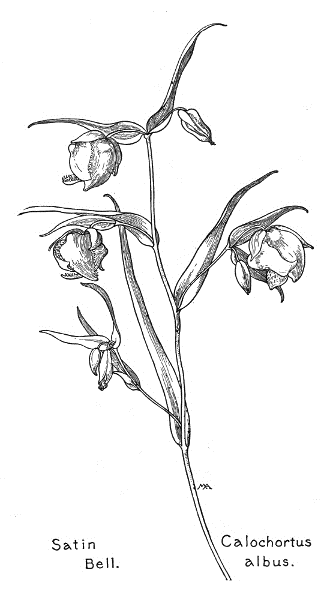
Satin Bell – Calochortus albus.

White Star Tulip
Calochórtus nùdus
White
Summer
California
This is a delicate and charming little flower, growing best in meadowy places in the woods of the Sierra Nevada Mountains at moderate altitudes, sometimes to a height of over seven thousand feet. The single, ribbonlike leaf is much taller than the flower-stalk, which is only a few inches high and bears several pretty flowers, measuring over an inch across, with pale-green sepals and three pure-white or pale-lilac, fan-shaped petals, with a little notch in the edge, almost without hairs and marked with a lilac crescent at the base; the honey-gland is divided crosswise by a toothed scale and the anthers are light blue. The nodding capsule is pointed at both ends.
White Pussy's Ears
Calochórtus Maweànus
White, gray
Spring
Cal., Oreg.
A charming little plant, with lovely little flowers, about an inch across, with white or pale-lilac sepals and white petals, hairy all over inside, often lilac at the base, the crescent-shaped gland covered with violet hairs and the anthers and pistil lilac. Usually the general effect is of a most delicate shade of gray and the little blossoms do not droop, but look straight up at one from among the grass. This is common in northern California.
Yellow Pussy's Ears.
Yellow Star Tulip.
Calochórtus Bénthami
Yellow
Spring
California
Much like the last in character, from three to seven inches tall, with bluish-green, stiffish leaves and a few quaintly pretty flowers. They are about an inch across, clear light-yellow, with smooth sepals and the petals thickly covered with yellow hairs and sometimes brown at the base. This is common in the Sierra foothills.

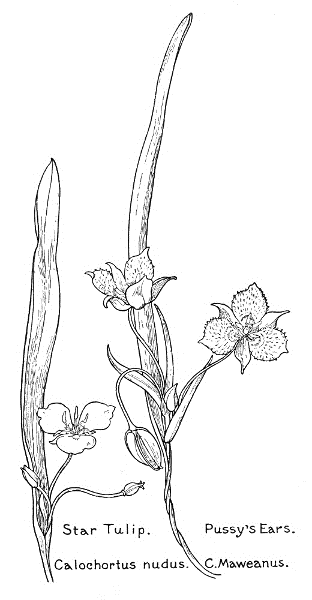
Star Tulip – Calochortus nudus.
Pussy's Ears – C. Maweanus.
Butterfly Tulip
Mariposa Tulip
Calochórtus lùteusvar. oculàtus
Many colors
Spring, summer
California
The commonest kind in northern California, found in both the Sierra Nevada and Coast Mountains, and one of the most beautiful of all the Mariposas. The broad petals, each about an inch and a half long, are usually white, lilac, or yellowish, with an "eye" like that on a peacock's feather, giving the name oculatus. Occasionally they are deep rose-color, as in the colored picture, though this is not typical, and have a vivid blotch of shaded maroon and crimson and an orange spot on each petal, with some maroon-colored hairs at the base. The sepals are striped with pink and maroon and twist into spirals as they fade; the pistil and the blunt anthers are mauve; the honey-gland narrowly crescent-shaped; the leaves pale-green and the delicate stem over a foot tall. This Mariposa is extremely variable and seems sometimes to merge into C. venústus, a similar kind, and gorgeous varieties of both may be seen along the Yosemite road on the down grade to Wawona. There are many similar Mariposas, but the casual flower-lover who finds any of these beautiful flowers will probably be satisfied to know that they are Butterfly Tulips, without going into the technical peculiarities which differentiate them.
Yellow Mariposa Tulip
Calochórtus lùteusvar. citrìnus
Yellow
Spring
California
A fine robust plant, about a foot tall, with a stout stem, light, bright green leaves, and exceedingly handsome flowers, over two inches across. The sepals are yellowish, with a black spot and streaks of brown, and the petals are deep lemon-yellow, each with a rich maroon spot near the center and a hairy, brown, crescent-shaped gland below, often flecked with maroon at the margins and base, with cream-colored anthers and a yellowish pistil. This is very much like a Tulip in character and looks very gay and cheerful growing in green fields. The typical C. luteus is similar, but smaller and duller in color.

Butterfly Tulip – Calochortus luteus. var. oculatus.
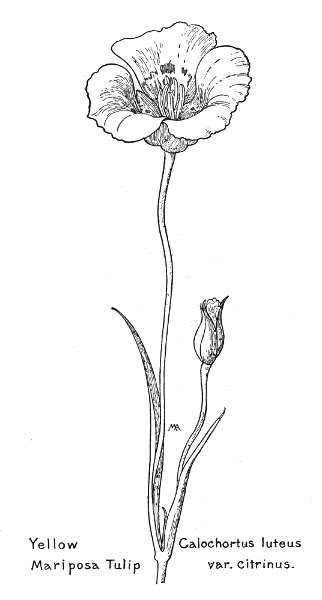
Yellow Mariposa Tulip – Calochortus luteus var. citrinus.
Orange Mariposa Tulip
Calochórtus Kénnedyi
Orange-red
SpringCal., Ariz.
A wonderful flower, exceedingly brilliant and unusual in color, not quite like anything else in nature. The stout, firm stem is from two inches to over a foot tall and the leaves are dark-green, with a delicate bluish "bloom." The flowers are about two inches across, with pale-green sepals, bordered with pale-pink and orange inside, and beautiful petals, thick in texture and easily bruised, delicate peach-color outside and bright orange-vermilion within, each petal ornamented with a purplish gland, covered with matted hairs and crossed with a band of long vermilion hairs. When the stems are very short the flaming flowers look like Crocuses, sprouting out of the barren desert soil, but when they are tall they have the gorgeous effect of Tulips. These plants grow in the Mohave Desert, but are rather rare in California. They are very abundant in the foothills and on the mountain slopes of Arizona, giving a beautiful orange-red color to the landscape for miles in spring, there being literally thousands in a small area.
Sego Lily
Mariposa Tulip
Calochórtus Nuttállii
White, pale lilac
Early summer
Ariz., Cal., Utah
These pretty flowers are about two inches across, their white petals tinged with yellowish-green or lilac, and often delicately fluted at the edges, often with hairy spots inside the petals at their base, the whole flower very variable in coloring. These Mariposas grow all through the Southwest. In the Grand Canyon they begin to come out early in May, among the dry grasses halfway down the Bright Angel trail, and are a lovely shade of clear lilac. The slender stem, about a foot tall, often bears a small bulb near the base. It is called Sego Lily (pronounced Sègo) in Utah and is the "State flower." Its bulbs formed a substantial part of the food of the early Mormon pioneers when they crossed the desert and the flower is therefore held in great esteem in Utah.
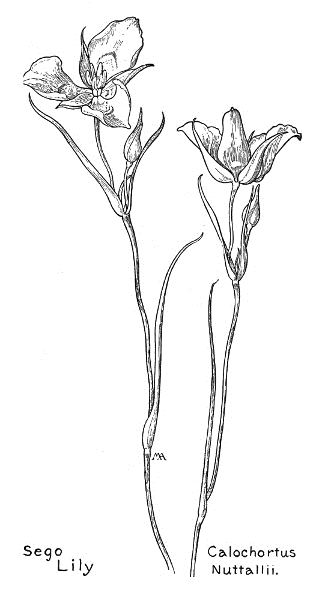
Sego Lily – Calochortus Nuttallii.
IRIS FAMILY. Iridaceae
A large family, widely distributed and found throughout our continent. Perennial herbs, with bracts; the leaves long, narrow, toothless, and sheathing; the flowers showy, perfect and regular, twisted in the bud, not falling off in withering, of three and six parts; the three stamens on the base of the sepals, their anthers turning outward; the single style with three branches; the ovary inferior, becoming a three-celled, usually three-angled, many-seeded capsule. This family is noticeably distinguished from the Lily family by the inferior ovary, and from the Amaryllis family by the three stamens.
There are many kinds of Iris. To the casual observer the flowers appear to have nine petals of different sizes, but in reality there are three sepals, three petals, and three petal-like branches of the style. The three outer divisions, or sepals, are large and spread or turn down; the three inner divisions, or petals, are usually narrower and are erect; the style branches arch over and under each is a stamen. The sepals and petals have claws, which are united below and form a tube; the capsule is large and contains many, flat, black seeds, in one or two rows in each cell; the large rootstock is usually fleshy. Iris is from the Greek for "rainbow," in allusion to the variegated tints, and Flower-de-luce from the French "fleur-de-lis," or "lily-flower." Many odd and beautiful kinds are cultivated from the Old World. Orris-root is made from the roots of a Florentine species.
Western Blue Flag
Ìris Missouriénsis
Violet, blue
Spring, summer
West, except Wash, and Oreg.
A very handsome and decorative plant, growing in large clumps, in damp situations, from stout, creeping rootstocks. The stiff, sword-shaped leaves, mostly shorter than the stems, are smooth and light bluish-green and the stout stems, from one to two feet high, bear usually two, pale-violet flowers, about three inches long, emerging from thin, papery bracts. The sepals are white, or pale blue, delicately veined with violet, with a yellow-veined rib down the middle, the petals are pale blue or pale violet, veined with purple, and the buds are yellowish, veined with brown. This grows in profusion in the Yosemite meadows, at the foot of El Capitan, and is delicately beautiful, but would be more effective if the coloring were a little stronger.
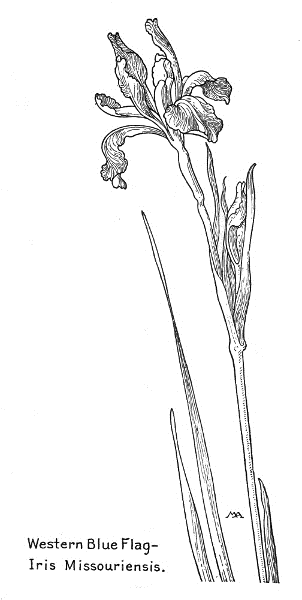
Western Blue Flag – Iris Missouriensis.
Douglas Iris
Ìris Douglasiàna
Purple, lilac, cream
Spring, summer
Cal., Oreg.
A beautiful kind, very common in the Coast Ranges. It grows in patches, or singly, and has rather dark green leaves, longer than the flower-stalks, and lovely flowers, which vary exceedingly in color. Near the coast they are usually bluish-purple, but in mountain woods they run from violet and mauve to pink, yellow, and white. They are often striped with white and yellow, delicately veined with purple, and measure three or four inches across. In the redwood forests, in northern California, they are peculiarly large and beautiful, their delicate tints of cream and straw-color, tinged with mauve and marked with reddish-purple, and wonderfully set off by their dark forest background. This kind often blooms throughout the rainy season, but chiefly in early spring.
Hartweg's Iris
Ìris Hartwégi
Yellow and violet
Summer
California
This odd and pretty little Iris grows in half-dry, open forests, in the Sierra Nevada Mountains. The many flower-stems, from six to twelve inches tall, are overtopped by some of the long, narrow leaves and the flowers are from one and a half to two inches long, either yellow, veined with violet, or pale-violet, veined with purple. The two color forms often grow together and attract much attention from tourists. They look very pretty, springing from a carpet of fallen pine-needles, in the forests along the Wawona road near Yosemite.
Ground Iris
Ìris macrosìphon
Blue, purple
Spring, winter
California
A beautiful kind, forming low clumps of many, very narrow leaves, from five to twenty inches long and much taller than the flower-stalks. The handsome flowers are over three inches across, bright purplish-blue, the sepals veined with darker color and marked with a white stripe. This is common on grassy hills near the coast and farther inland becomes taller and paler in color. The flowers are slightly sweet-scented and begin to bloom in January. The Hupa Indians used the leaves for making twine and rope for their nets and snares. There are many other beautiful western Irises.
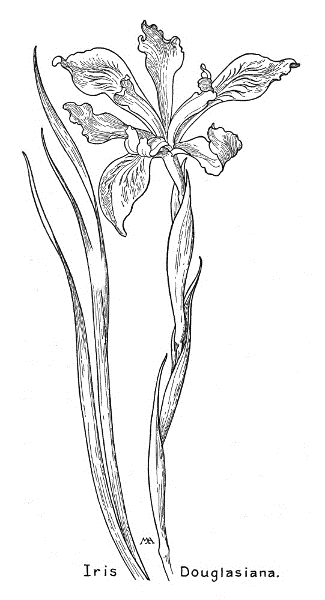
Iris Douglasiana.
There are numerous kinds of Sisyrinchium, attractive little plants, all American, many from South America; with fibrous roots; grasslike leaves; slender, flat stems, sometimes branching; papery and green bracts and pretty flowers, that soon wither, on very slender pedicels, the six spreading divisions all alike; the filaments of the stamens united; the style branches slender, the capsule roundish, containing round seeds.
Blue-Eyed Grass
Sisyrínchium béllum
Blue
Summer
Cal., Oreg.
The deep blue stars of this pretty plant are a beautiful feature of the fields near Santa Barbara, and in other parts of California, in summer; in fact they are so plentiful in some places that they are a menace to the farmers. They grow in clumps, about a foot tall, among the grass. The stems are somewhat branching, the leaves are shorter than the stem, and the bracts are about an inch long, green and sheathing. There are about seven flowers on each stem, in a loose cluster, each about an inch across and handsomer than their relations in the East. They vary in tint from bright blue to purple, with a yellow "eye," and their divisions are prettily notched at the tips, with a little prong. The anthers are arrow-shaped, the style short, with three very small stigmas, and the small, oddly-shaped, little capsule is dark-brown when ripe, and perhaps suggested one of the common names, Nigger-babies. It is called Azulea and Villela by Spanish-Californians.
Golden-Eyed Grass
Sisyrínchium Califórnicum
Yellow
Spring, summer
Cal., Oreg.
This is very much like Blue-eyed Grass, but the flowers are bright yellow, the stems are about a foot tall, broadly winged and not branching, and the leaves are somewhat broader. The pretty flowers are nearly an inch across and there are from three to seven in a cluster. The filaments are united at the base only, the style is cleft to below the middle, and the small capsule is rather oblong. This grows in swampy places near the ocean. S. Arizònicum has yellow flowers and branching stems and grows in Arizona. S. Élmeri also has yellow flowers, with purple lines, and is found in wet places in the Sierras. When pressed and dried the yellow-flowered Sisyrinchiums stain the paper reddish-purple.
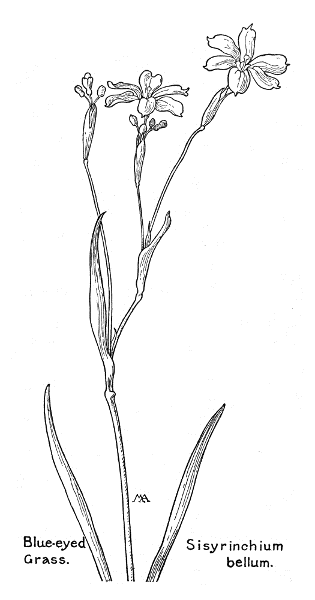
Blue-eyed Grass – Sisyrinchium bellum.
ORCHID FAMILY. Orchidaceae
A very large family, most abundant in the tropics; curious plants, with oddly beautiful flowers. Perhaps because they are also rather rare they seem to have a peculiar fascination for the public; in fact almost any strangely-shaped flower is apt to be dubbed an orchid by the passer-by. They are perennial herbs, with various kinds of roots, some of them parasitic, usually with alternate, toothless leaves, the lower ones sheathing the stem. In some kinds the leaves have dwindled to scales. The flowers are perfect, irregular, with six divisions; the three sepals are alike and colored like petals; two of the three petals are alike, but the central one differs in size and shape and is called the lip. This is conspicuously colored, often spurred, and contains nectar for the attraction of "long-tongued" insects, on which these plants depend mostly for cross-pollination. The mechanism for this purpose is curious and interesting. The stigma is usually a broad sticky surface and its style is united with the filaments and forms, in front of the lip, a column which is usually capped by a single two-celled anther, containing two clusters of pollen, one in each cell. Each cluster consists of a few waxy grains, held together by cobweb-like threads, which run together and terminate in a sticky disk. These disks adhere to the insects, which push in to get the nectar, and are transported to the gummy stigma of another flower. The inferior ovary develops into a three-valved capsule, containing numerous minute seeds. Orchis is the ancient Greek name.
There is only one kind of Cephalanthera in North America; with creeping rootstocks; flowers in terminal spikes, with bracts; sepals and petals nearly equal; petals somewhat united and hooded; lip more or less pouched.
Phantom Orchis
Cephalanthèra Austínae
White
Summer
Northwest
In dense mountain forests these strange plants shimmer like pallid ghosts among the dark trees. They are pure translucent white throughout, stem and all, and the leaves have shrunk to white sheaths, an inch or two long. The stems are one to two feet tall and bear spikes of numerous flowers, each over half an inch long, with the lip shorter than the sepals and petals, which are alike. They are beautiful and yet not quite pleasing, for we feel instinctively that there is something unnatural about them and, indeed, the strange absence of any green coloring matter in their make-up indicates that they are incapable of making their own food from the elements and draw their nourishment from decaying vegetation, or are parasitic on other plants. They range northward from Yosemite but are nowhere very abundant. I found several growing near the trail from Little Yosemite Valley to Cloud's Rest and a good many in the woods near the foot of Mt. Shasta, where they seem to be quite common.

Phantom Orchis – Cephalanthera Austinae.
There are several kinds of Serapias, widely distributed; tall, stout herbs, with creeping rootstocks and leafy stems; the leaves plaited lengthwise and clasping at base; the flowers with leafy bracts, in terminal racemes. The flowers have no spur; the sepals and petals are separate and nearly equal; the lip broad, free, concave below, constricted near the middle.
Stream Orchis Chatter-box
Seràpias gigantèa(Epipactis)
Reddish and greenish-yellow
Summer
West, etc.
A handsome plant, decorative and curious in form and unusual in coloring. It is from one to four feet tall, with a stout, leafy stem bearing three to ten flowers and smoothish leaves, with prominent veins. The sepals are reddish or greenish-yellow and the petals pinkish, veined with maroon. The lip is pouched at the base, with a winged margin and a pendulous tip, which swings freely as if on a hinge, so that it quivers when the plant is shaken. Although the flowers are very handsome this curious tremulous motion, which makes them seem almost alive, gives them a quaint likeness to an old woman in a sunbonnet, with a hooked nose and chattering jaw. They have a slight scent and the plant is quite common along streams and in wet places, in the West and in Colorado and Texas. Some botanists think it is identical with a variety which grows in the Himalaya Mountains. It was named for the Egyptian deity, Serapis.

Stream Orchis – Serapias gigantea.
There are several kinds of Corallorrhiza, widely distributed in the north temperate zone and growing in dense woods; pinkish or straw-colored plants, more or less parasitic, with large roots resembling branches of coral; the leaves all reduced to sheathing, papery scales; the flowers in terminal racemes, without bracts, on short pedicels, which turn down in fruit, mostly with a short spur, the sepals and petals about equal, the upper ones curving in.
Coral-root
Corallorrhìza multiflòra
Reddish-yellow
Summer
Wash., Oreg., Cal., Utah
The curious knobby rootstock, shaped like a bit of coral, gives the name to this strange and rather unwholesome looking plant. From living on decayed vegetation it has lost its green leaves, and has only a few papery sheaths in their place, and the thick, translucent stem is pale and smooth, from one to two feet tall, pink at the base, shading to golden-brown towards the top. The flowers, less than half an inch across, are usually yellow, with reddish-brown tips, and the white, three-lobed lip is spotted with purple. The buds are yellow and brown and the whole color effect is very pretty, as if the plant were trying to match the russet tints of the floor of the forest. The flowers vary from several to many and grow in a long cluster, hanging down when their seeds begin to ripen. This is widely distributed, growing also in the East, but nowhere common.
Coral-root
Corallorrhìza Bigelòwii
Reddish-yellow
Summer
Wash., Oreg., Cal., Utah
This is a similar plant, but handsomer, with much larger flowers, duller in coloring and striped not spotted. Instead of a spur the base of the sepals is swollen over the ovary, which develops gradually into an oblong fruit to which the flower still clings, so that the older flowers, on the lower part of the stalk, give an odd effect of having long, swollen necks. The seeds are small and numerous. There are other kinds, similar in general effect.
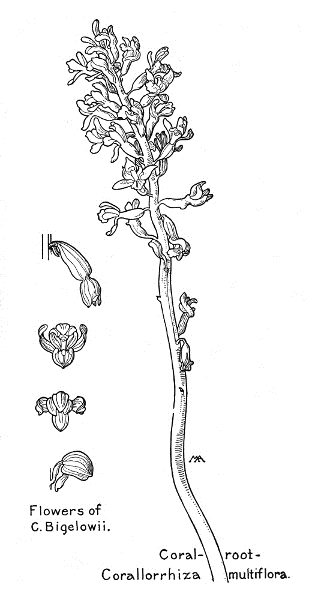
Flowers of C. Bigelowii.
Coral-root – Corallorrhiza multiflora.
There are numerous kinds of Limnorchis; the lower leaves clasping or sheathing the stem; the flowers mostly in spikes or racemes; sepals nearly equal, petals mostly smaller than the sepals; lip spreading or drooping, not toothed or lobed, with a spur. The Latin name means "marsh-dweller."
Sierra Rein Orchis
Limnórchis leucostàchys
(Habenaria)
White
Summer
Cal., Oreg., Wash.
Often in some favorable corner of a marsh, near the woods, we may see a dozen of these lovely plants, their robust leafy stalks sometimes as much as four feet tall, rearing their delicate spires of bloom above the lush grass. The long narrow leaves are bright-green and smooth and the numerous, small, delicate blossoms, sprinkled thickly along the stem, are pure white, each with a very long spur like a little tail, each with a green bract at the base of its little pedicel, and deliciously fragrant. There are several similar kinds, mostly with green flowers; this is the handsomest and least rare.
There are many kinds of Cypripedium, with large, broad leaves and one or several, large, drooping flowers, with two fertile anthers, with short filaments, one on each side of the column below the stigma, and a conspicuous, petal-like, sterile anther, arching over the stigma. They are easily known by the curious lip, which is a large inflated sac, suggesting both the common names, Lady's Slipper and Indian Moccasin, and the Greek, meaning "foot of Venus."
Mountain Lady's Slipper
Cypripèdium montànum
Brown and white
Summer
Northwest
Beautiful and decorative, with a stout, hairy stem, one to two feet tall and a few handsome flowers, rich and harmonious though not brilliant in coloring, with a lip about an inch long, dull-white, veined with purple, and brownish or purplish sepals and petals, very long, narrow, and twisted. This grows in mountain woods and is found around Yosemite. There is a picture in Miss Parsons's Wild Flowers of California. C. Califórnicum is similar, but with more flowers, the sepals and petals greenish-yellow, the lip pinkish. C. parviflòrum has a yellow lip and purplish sepals and grows in northern woods, across the continent. None of these plants is common.
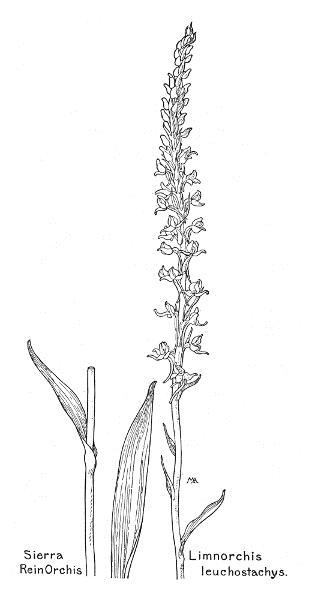
Sierra Rein Orchis – Limnorchis leucostachys.

